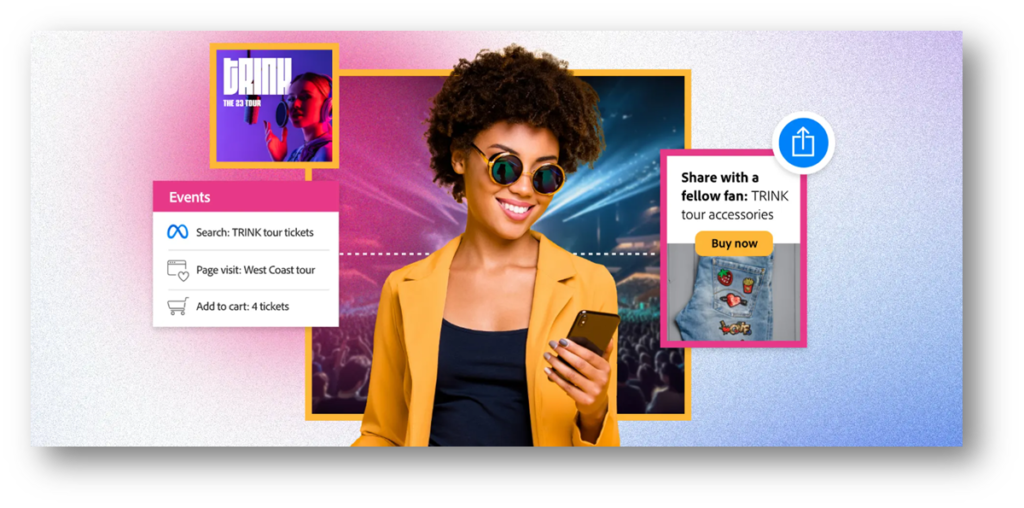Event forwarding the easy way – getting started with Adobe Real-Time CDP and Meta Conversions API
November 30, 2023This article was originally published on Adobe website. Click here to see the original blog post.

Now that app users can easily opt out of tracking and the deprecation of third-party cookies is underway, it’s increasingly difficult to ensure your advertising partners are sharing relevant content with your customers. Meanwhile, the consequences of getting it wrong are bigger than ever. According to the latest Adobe Trust report, 58% of customers will stop purchasing from a brand that doesn’t give them the personal experiences they value.
“Marketers need a way to connect their first-party data — which is the data customers allow you to collect from your website and other sources — with the platforms that serve up ads,” says Travis Jordan, a principal product manager at Adobe. To do this in real time, a growing number of businesses are connecting their first-party customer data to ad platforms like Meta using a technique called event forwarding.
Scalable event forwarding
Event forwarding is a server-side solution that enables the near real-time transfer of event data to any destination. It lets you securely share first-party data describing customer behavior with third parties, so ads and other content can be tailored more specifically to each customer’s interests and stage of the buyer’s journey — all while staying compliant with privacy rules.
“For example, let’s say a customer visits your website and gives consent for you to capture their on-site behavior so you can provide a more personalized experience,” Jordan says. “With event forwarding, you can send data about their behavior during that browsing session to your ad platform, which can then use it to choose the most relevant ads to display.”
Marketers love this idea, but IT organizations, which are responsible for making it work, can be hesitant. They worry about having to build and scale custom connectors, maintain the security of data flows, and more.
Event forwarding with Meta’s Conversions API
“The good news is that you can quickly and securely connect your marketing data to the largest ad platforms with prebuilt APIs,” Jordan says. “A great example of this is Meta’s Conversions API.”
The Conversions API is a Meta business tool that creates a direct connection between your marketing data and the Meta technologies that optimize ad performance. This helps you to use your own marketing data to optimize ad targeting, decrease cost per action, and see a more complete picture of campaign outcomes while respecting people’s privacy.
Like many advertisers, you may be used to sharing web data with Meta using the Meta Pixel. Unlike the Meta Pixel, the Conversions API isn’t just for website data. You can send cross-channel (web, app, and offline) marketing data about your customer interactions, allowing you to focus on the most important data for your business. In other words, Conversions API can help you to increase ad performance with extended use of your data, improve your measurement capabilities, and help you see a more complete picture of campaign outcomes while respecting people’s privacy.
It’s not a question of if but rather when you’ll need to transition to the Conversions API. And innovative, data-driven businesses are implementing this solution now because it’s helping give them the edge they need to compete today. Global large advertisers with the Meta Pixel who set up the Conversions API saw on average +19% additional attributed purchase events.*
*Based on analysis of >1K global large advertisers with direct, Conversions API Gateway or partner integrations (partner integrations only included if >1000 integrations exist) between 1/1/2022 and 3/31/2022 with criteria of at least 50 server and browser events, an EMQ score > 5, server coverage of > 90% (but no higher than 300% to eliminate outliers).
Simplified implementation
To make getting started with Conversions API easier, Adobe has partnered with Meta to create an extension in Adobe Real-Time Customer Data Platform Connections. “This extension allows companies to seamlessly connect to the Conversions API without extensive coding and maintenance,” Jordan says.
Real-Time CDP Connections streamlines how data is collected and distributed to other systems while improving site performance and minimizing updates. Businesses use tags — also known as tracking code — on their digital properties to share event data with partners for advertising, analytics, personalization, and more. “Real-Time CDP Connections allows companies to offload tags execution from the client side to our edge servers,” Jordan says.
With Adobe’s quick-start workflows available in Real-Time CDP Connections, it takes just minutes to get up and running with the extension and start sending data to Meta on the server side. The workflow takes you through four easy steps to set up, implement, validate, and review.
Starting where you are
In addition to making it much easier to get started with event forwarding, Real-Time CDP Connections is also a great starting point for companies with longer-term plans to deploy a CDP. “You can easily transition from Real-Time CDP Connections to our Prime and Ultimate CDP solutions,” says Jordan.
Real-Time CDP Prime lets you assemble known and unknown data into unified profiles, create audiences, and personalize experiences. By upgrading to Real-Time CDP Ultimate, you can establish a single view of customers across all enterprise systems and channels, with advanced personalization, API connections, and governance requirements.
“Combining event forwarding with a CDP that contains unified customer profiles informed by data from all your touchpoints is the gold standard when designing personalized experiences,” Jordan says.
Take the next step with Adobe and Meta
Event forwarding is a great strategy for delivering more personalized marketing grounded in first-party data. Accessing Meta’s Conversions API from Adobe Real-Time CDP Connections is one of the fastest and easiest ways to get started.
To learn more, email metapartner@adobe.com.
Nina Caruso is a senior product marketing manager on the Adobe Real-Time CDP product marketing team. Prior to her role in product marketing, she led a consulting team at Adobe focused on data management technical implementations. Nina is experienced in data management implementation design, audience strategy, and personalization best practices.


